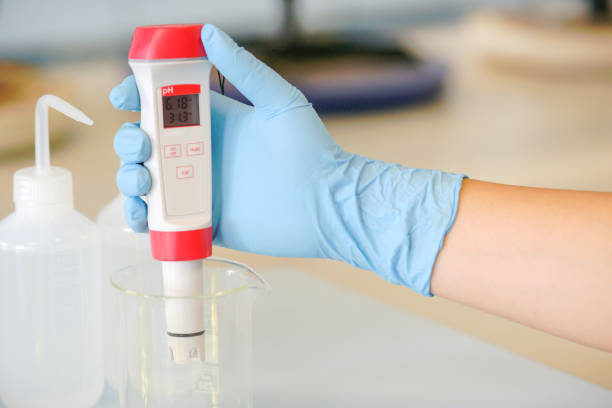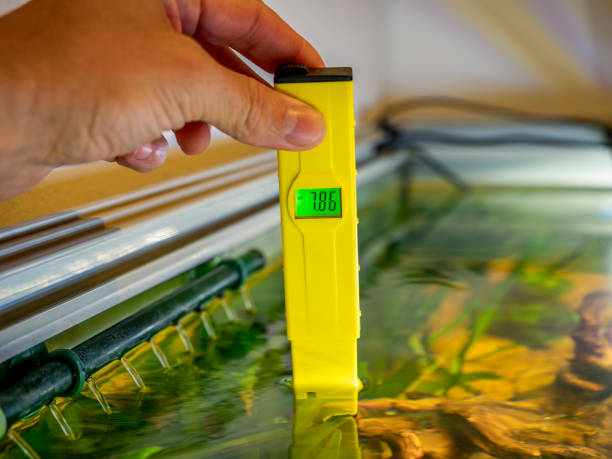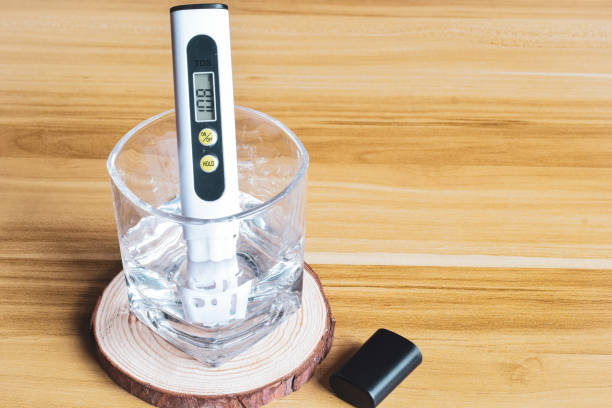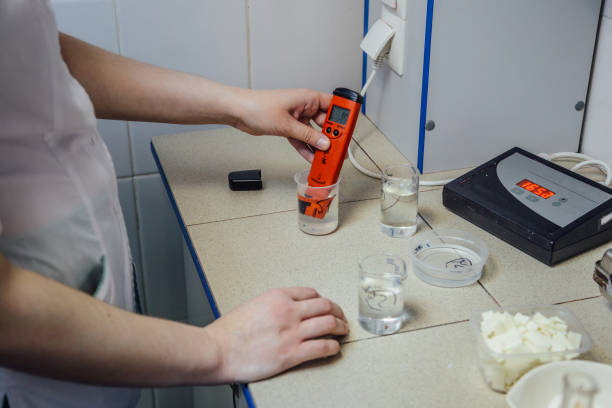In today’s world of scientific research, environmental monitoring, industrial processing, and quality control, accurate pH measurement is crucial. The digital pH meter has become a vital tool across laboratories and field settings due to its precision, efficiency, and ease of use. This guide presents everything you need to know about digital pH meters, from working principles to applications, maintenance, and expert tips.
Introduction to Digital pH Meter
A digital pH meter is an analytical device crafted to accurately and reliably determine the hydrogen ion concentration (pH level) of a liquid solution. Unlike conventional pH indicators or litmus paper, it provides exact numerical readings, usually accurate to within ±0.01 pH units, that are displayed immediately on an LCD or LED screen.
These instruments consist of three main parts:
- pH Electrode (Sensor)
- Reference Electrode
- Digital Display and Processor
Together, they measure the voltage difference between the two electrodes and convert it into a readable pH value.
How Does a Digital pH Meter Work?

The working principle of a digital pH meter is based on the Nernst equation, which relates the voltage produced by a pH-sensitive electrode to the hydrogen ion concentration of the solution.
When the glass membrane of the pH electrode comes into contact with a solution, hydrogen ions interact with it, producing a small electrical potential. This potential is then compared with the stable reference electrode. The microprocessor inside the meter interprets this potential difference and translates it into a digital pH value on the display.
Types of Digital pH Meters
Different industries and applications require various types of pH meters. Below are the major categories:
1. Benchtop pH Meters
Ideal for laboratory use, these meters are known for high accuracy, multi-parameter capabilities, and advanced data logging. They are commonly used in pharmaceuticals, biotechnology, and food labs.
2. Portable pH Meters
Compact and battery-powered, portable meters are perfect for on-site pH testing in industries like agriculture, environmental science, and water treatment.
3. Pen-style pH Meters
Affordable and easy to carry, pen-style meters are suitable for basic pH testing in aquariums, hydroponics, and home labs.
4. Online/Inline pH Meters
These are integrated into industrial pipelines or reactors for real-time, continuous monitoring, making them ideal for chemical plants and wastewater facilities.
Key Features of a High-Quality Digital pH Meter

When selecting a digital pH meter, the following features are essential for accuracy, reliability, and longevity:
- Automatic Temperature Compensation (ATC): Adjusts the pH reading based on solution temperature.
- Calibration Capability: Should support 1-point, 2-point, or 3-point calibration.
- Waterproof Housing: Important for fieldwork and lab safety.
- Replaceable Electrodes: Extends device life and improves accuracy.
- Data Storage and Transfer: USB or Bluetooth options for saving and sharing readings.
Applications of Digital pH Meters
Digital pH meters are versatile and used in a broad range of industries:
1. Water Treatment
Digital pH meters monitor municipal and industrial wastewater to ensure it meets environmental regulations.
2. Agriculture
In soil testing, maintaining optimal pH levels enhances crop yield and plant health.
3. Food & Beverage
Maintaining proper pH is crucial in fermentation, dairy production, and brewing, ensuring product consistency and safety.
4. Pharmaceuticals
Precise pH measurements are vital in drug formulation, stability testing, and clinical research.
5. Environmental Monitoring
Used to measure the pH of natural water bodies, helping detect pollution and acid rain.
6. Cosmetics Industry
Ensures the pH of products aligns with skin compatibility standards.
How to Use a Digital pH Meter
To ensure accurate results, follow these steps:
- Calibrate the Meter
Use standard buffer solutions (pH 4.0, 7.0, and 10.0) to calibrate the meter before use. - Rinse the Electrode
Rinse with distilled water to avoid contamination. - Immerse in the Sample
Dip the electrode into the test solution, ensuring full immersion of the glass bulb. - Wait for Stabilization
Wait a few seconds for the reading to settle on the digital display. - Record the pH Value
- Rinse and Store the Electrode
After use, rinse again and store the electrode in a storage solution, not distilled water, to preserve the membrane.
Calibration of Digital pH Meter
Regular calibration is critical for maintaining accuracy. Follow the device’s instructions for:
- Manual Calibration: Adjusting readings manually after each buffer.
- Automatic Calibration: The meter auto-detects and adjusts based on the buffer.
We recommend calibrating:
- Daily for critical applications
- Weekly for general usage
- After prolonged storage or electrode replacement
Maintenance and Storage Tips

Proper care extends the life of your digital pH meter:
- Clean Electrodes Weekly using electrode cleaning solutions.
- Avoid touching the Glass Bulb, as oils from the skin can interfere with readings.
- Store Electrodes in Proper Solution, never let them dry.
- Check for Cracks or Air Bubbles inside the electrode, which can cause erratic readings.
- Replace Electrodes Periodically, usually every 12–18 months.
Common Errors and Troubleshooting
Here are some common issues and their solutions:
- Unstable Readings: Check for air bubbles, recalibrate, or replace the electrode.
- Slow Response Time: Clean the electrode or replace it if it is aging.
- Erratic Values: Ensure proper calibration and remove any static interference.
- Meter Not Turning On: Replace batteries or check the power supply.
Advantages of Digital pH Meters Over Analog Meters
- Higher Accuracy
- Faster Results
- Easy Calibration
- Data Logging Capabilities
- Temperature Compensation
- User-Friendly Interface
Digital pH meters provide an unmatched combination of precision, versatility, and ease of use, making them indispensable across sectors.
Top Brands and Models to Consider
Some leading digital pH meter brands include:
- Hanna Instruments – Advanced lab and field models
- Thermo Scientific Orion – High-end lab pH meters
- Apera Instruments – Reliable and budget-friendly options
- Milwaukee Instruments – Popular among growers and hydroponics users
- Bluelab – Trusted in agriculture and horticulture
Final Thoughts
Whether you’re a lab technician, research scientist, or agronomist, investing in a digital pH meter ensures you get precise and reliable pH measurements every time. Choosing the right type, maintaining it properly, and calibrating regularly will guarantee long-term performance and data integrity.
What is the principle of a pH meter?
In today’s world of scientific research, environmental monitoring, industrial processing, and quality control, accurate pH measurement is crucial. The digital pH meter has become a vital tool across laboratories and field settings due to its precision, efficiency, and ease of use. This guide presents everything you need to know about digital pH meters, from working principles to applications, maintenance, and expert tips.
A digital pH meter is an analytical device crafted to accurately and reliably determine the hydrogen ion concentration (pH level) of a liquid solution. Unlike conventional pH indicators or litmus paper, it provides exact numerical readings, usually accurate to within ±0.01 pH units, that are displayed immediately on an LCD or LED screen.
These instruments consist of three main parts:
pH Electrode (Sensor)
Reference Electrode
Digital Display and Processor
Together, they measure the voltage difference between the two electrodes and convert it into a readable pH value.
How Does a Digital pH Meter Work?
The working principle of a digital pH meter is based on the Nernst equation, which relates the voltage produced by a pH-sensitive electrode to the hydrogen ion concentration of the solution.
When the glass membrane of the pH electrode comes into contact with a solution, hydrogen ions interact with it, producing a small electrical potential. This potential is then compared with the stable reference electrode. The microprocessor inside the meter interprets this potential difference and translates it into a digital pH value on the display.
Types of Digital pH Meters
Different industries and applications require various types of pH meters. Below are the major categories:
1. Benchtop pH Meters
Ideal for laboratory use, these meters are known for high accuracy, multi-parameter capabilities, and advanced data logging. They are commonly used in pharmaceuticals, biotechnology, and food labs.
2. Portable pH Meters
Compact and battery-powered, portable meters are perfect for on-site pH testing in industries like agriculture, environmental science, and water treatment.
3. Pen-style pH Meters
Affordable and easy to carry, pen-style meters are suitable for basic pH testing in aquariums, hydroponics, and home labs.
4. Online/Inline pH Meters
These are integrated into industrial pipelines or reactors for real-time, continuous monitoring, making them ideal for chemical plants and wastewater facilities.
Key Features of a High-Quality Digital pH Meter
When selecting a digital pH meter, the following features are essential for accuracy, reliability, and longevity:
Automatic Temperature Compensation (ATC): Adjusts the pH reading based on solution temperature.
Calibration Capability: Should support 1-point, 2-point, or 3-point calibration.
Waterproof Housing: Important for fieldwork and lab safety.
Replaceable Electrodes: Extends device life and improves accuracy.
Data Storage and Transfer: USB or Bluetooth options for saving and sharing readings.
Applications of Digital pH Meters
Digital pH meters are versatile and used in a broad range of industries:
1. Water Treatment
Digital pH meters monitor municipal and industrial wastewater to ensure it meets environmental regulations.
2. Agriculture
In soil testing, maintaining optimal pH levels enhances crop yield and plant health.
3. Food & Beverage
Maintaining proper pH is crucial in fermentation, dairy production, and brewing, ensuring product consistency and safety.
4. Pharmaceuticals
Precise pH measurements are vital in drug formulation, stability testing, and clinical research.
5. Environmental Monitoring
Used to measure the pH of natural water bodies, helping detect pollution and acid rain.
6. Cosmetics Industry
Ensures the pH of products aligns with skin compatibility standards.
How to Use a Digital pH Meter
To ensure accurate results, follow these steps:
Calibrate the Meter
Use standard buffer solutions (pH 4.0, 7.0, and 10.0) to calibrate the meter before use.
Rinse the Electrode
Rinse with distilled water to avoid contamination.
Immerse in the Sample
Dip the electrode into the test solution, ensuring full immersion of the glass bulb.
Wait for Stabilization
Wait a few seconds for the reading to settle on the digital display.
Record the pH Value
Rinse and Store the Electrode
After use, rinse again and store the electrode in a storage solution, not distilled water, to preserve the membrane.
Calibration of Digital pH Meter
Regular calibration is critical for maintaining accuracy. Follow the device’s instructions for:
Manual Calibration: Adjusting readings manually after each buffer.
Automatic Calibration: The meter auto-detects and adjusts based on the buffer.
We recommend calibrating:
Daily for critical applications
Weekly for general usage
After prolonged storage or electrode replacement
Maintenance and Storage Tips
Proper care extends the life of your digital pH meter:
Clean Electrodes Weekly using electrode cleaning solutions.
Avoid touching the Glass Bulb, as oils from the skin can interfere with readings.
Store Electrodes in Proper Solution, never let them dry.
Check for Cracks or Air Bubbles inside the electrode, which can cause erratic readings.
Replace Electrodes Periodically, usually every 12–18 months.
Common Errors and Troubleshooting
Here are some common issues and their solutions:
Unstable Readings: Check for air bubbles, recalibrate, or replace the electrode.
Slow Response Time: Clean the electrode or replace it if it is aging.
Erratic Values: Ensure proper calibration and remove any static interference.
Meter Not Turning On: Replace batteries or check the power supply.
Advantages of Digital pH Meters Over Analog Meters
Higher Accuracy
Faster Results
Easy Calibration
Data Logging Capabilities
Temperature Compensation
User-Friendly Interface
Digital pH meters provide an unmatched combination of precision, versatility, and ease of use, making them indispensable across sectors.
Top Brands and Models to Consider
Some leading digital pH meter brands include:
Hanna Instruments – Advanced lab and field models
Thermo Scientific Orion – High-end lab pH meters
Apera Instruments – Reliable and budget-friendly options
Milwaukee Instruments – Popular among growers and hydroponics users
Bluelab – Trusted in agriculture and horticulture
Final Thoughts
Whether you’re a lab technician, research scientist, or agronomist, investing in a digital pH meter ensures you get precise and reliable pH measurements every time. Choosing the right type, maintaining it properly, and calibrating regularly will guarantee long-term performance and data integrity.
What are the advantages of digital pH meters?
Higher Accuracy
Faster Results
Easy Calibration
Data Logging Capabilities
Temperature Compensation
User-Friendly Interface
Digital pH meters provide an unmatched combination of precision, versatility, and ease of use, making them indispensable across sectors.
What is a Digital pH Meter?
In today’s world of scientific research, environmental monitoring, industrial processing, and quality control, accurate pH measurement is crucial. The digital pH meter has become a vital tool across laboratories and field settings due to its precision, efficiency, and ease of use. This guide presents everything you need to know about digital pH meters, from working principles to applications, maintenance, and expert tips.
A digital pH meter is an analytical device crafted to accurately and reliably determine the hydrogen ion concentration (pH level) of a liquid solution. Unlike conventional pH indicators or litmus paper, it provides exact numerical readings, usually accurate to within ±0.01 pH units, that are displayed immediately on an LCD or LED screen.
These instruments consist of three main parts:
pH Electrode (Sensor)
Reference Electrode
Digital Display and Processor
Together, they measure the voltage difference between the two electrodes and convert it into a readable pH value.
How Does a Digital pH Meter Work?
The working principle of a digital pH meter is based on the Nernst equation, which relates the voltage produced by a pH-sensitive electrode to the hydrogen ion concentration of the solution.
When the glass membrane of the pH electrode comes into contact with a solution, hydrogen ions interact with it, producing a small electrical potential. This potential is then compared with the stable reference electrode. The microprocessor inside the meter interprets this potential difference and translates it into a digital pH value on the display.
Types of Digital pH Meters
Different industries and applications require various types of pH meters. Below are the major categories:
1. Benchtop pH Meters
Ideal for laboratory use, these meters are known for high accuracy, multi-parameter capabilities, and advanced data logging. They are commonly used in pharmaceuticals, biotechnology, and food labs.
2. Portable pH Meters
Compact and battery-powered, portable meters are perfect for on-site pH testing in industries like agriculture, environmental science, and water treatment.
3. Pen-style pH Meters
Affordable and easy to carry, pen-style meters are suitable for basic pH testing in aquariums, hydroponics, and home labs.
4. Online/Inline pH Meters
These are integrated into industrial pipelines or reactors for real-time, continuous monitoring, making them ideal for chemical plants and wastewater facilities.
Key Features of a High-Quality Digital pH Meter
When selecting a digital pH meter, the following features are essential for accuracy, reliability, and longevity:
Automatic Temperature Compensation (ATC): Adjusts the pH reading based on solution temperature.
Calibration Capability: Should support 1-point, 2-point, or 3-point calibration.
Waterproof Housing: Important for fieldwork and lab safety.
Replaceable Electrodes: Extends device life and improves accuracy.
Data Storage and Transfer: USB or Bluetooth options for saving and sharing readings.
Applications of Digital pH Meters
Digital pH meters are versatile and used in a broad range of industries:
1. Water Treatment
Digital pH meters monitor municipal and industrial wastewater to ensure it meets environmental regulations.
2. Agriculture
In soil testing, maintaining optimal pH levels enhances crop yield and plant health.
3. Food & Beverage
Maintaining proper pH is crucial in fermentation, dairy production, and brewing, ensuring product consistency and safety.
4. Pharmaceuticals
Precise pH measurements are vital in drug formulation, stability testing, and clinical research.
5. Environmental Monitoring
Used to measure the pH of natural water bodies, helping detect pollution and acid rain.
6. Cosmetics Industry
Ensures the pH of products aligns with skin compatibility standards.
How to Use a Digital pH Meter
To ensure accurate results, follow these steps:
Calibrate the Meter
Use standard buffer solutions (pH 4.0, 7.0, and 10.0) to calibrate the meter before use.
Rinse the Electrode
Rinse with distilled water to avoid contamination.
Immerse in the Sample
Dip the electrode into the test solution, ensuring full immersion of the glass bulb.
Wait for Stabilization
Wait a few seconds for the reading to settle on the digital display.
Record the pH Value
Rinse and Store the Electrode
After use, rinse again and store the electrode in a storage solution, not distilled water, to preserve the membrane.
Calibration of Digital pH Meter
Regular calibration is critical for maintaining accuracy. Follow the device’s instructions for:
Manual Calibration: Adjusting readings manually after each buffer.
Automatic Calibration: The meter auto-detects and adjusts based on the buffer.
We recommend calibrating:
Daily for critical applications
Weekly for general usage
After prolonged storage or electrode replacement
Maintenance and Storage Tips
Proper care extends the life of your digital pH meter:
Clean Electrodes Weekly using electrode cleaning solutions.
Avoid touching the Glass Bulb, as oils from the skin can interfere with readings.
Store Electrodes in Proper Solution, never let them dry.
Check for Cracks or Air Bubbles inside the electrode, which can cause erratic readings.
Replace Electrodes Periodically, usually every 12–18 months.
Common Errors and Troubleshooting
Here are some common issues and their solutions:
Unstable Readings: Check for air bubbles, recalibrate, or replace the electrode.
Slow Response Time: Clean the electrode or replace it if it is aging.
Erratic Values: Ensure proper calibration and remove any static interference.
Meter Not Turning On: Replace batteries or check the power supply.
Advantages of Digital pH Meters Over Analog Meters
Higher Accuracy
Faster Results
Easy Calibration
Data Logging Capabilities
Temperature Compensation
User-Friendly Interface
Digital pH meters provide an unmatched combination of precision, versatility, and ease of use, making them indispensable across sectors.
Top Brands and Models to Consider
Some leading digital pH meter brands include:
Hanna Instruments – Advanced lab and field models
Thermo Scientific Orion – High-end lab pH meters
Apera Instruments – Reliable and budget-friendly options
Milwaukee Instruments – Popular among growers and hydroponics users
Bluelab – Trusted in agriculture and horticulture
Final Thoughts
Whether you’re a lab technician, research scientist, or agronomist, investing in a digital pH meter ensures you get precise and reliable pH measurements every time. Choosing the right type, maintaining it properly, and calibrating regularly will guarantee long-term performance and data integrity.
What are the applications of Digital pH Meters?
Digital pH meters are versatile and used in a broad range of industries:
1. Water Treatment
Digital pH meters monitor municipal and industrial wastewater to ensure it meets environmental regulations.
2. Agriculture
In soil testing, maintaining optimal pH levels enhances crop yield and plant health.
3. Food & Beverage
Maintaining proper pH is crucial in fermentation, dairy production, and brewing, ensuring product consistency and safety.
4. Pharmaceuticals
Precise pH measurements are vital in drug formulation, stability testing, and clinical research.
5. Environmental Monitoring
Used to measure the pH of natural water bodies, helping detect pollution and acid rain.
6. Cosmetics Industry
Ensures the pH of products aligns with skin compatibility standards.
